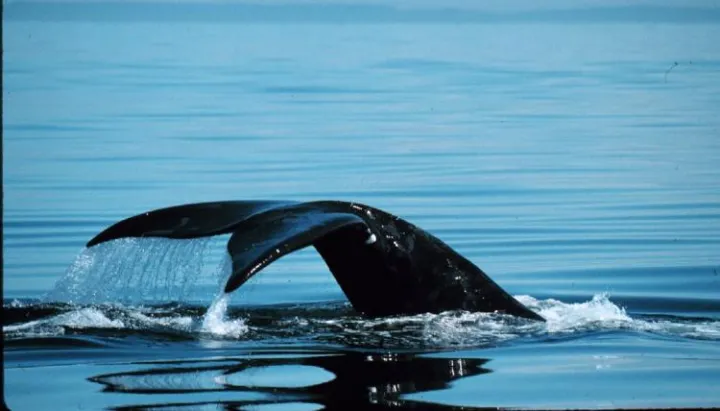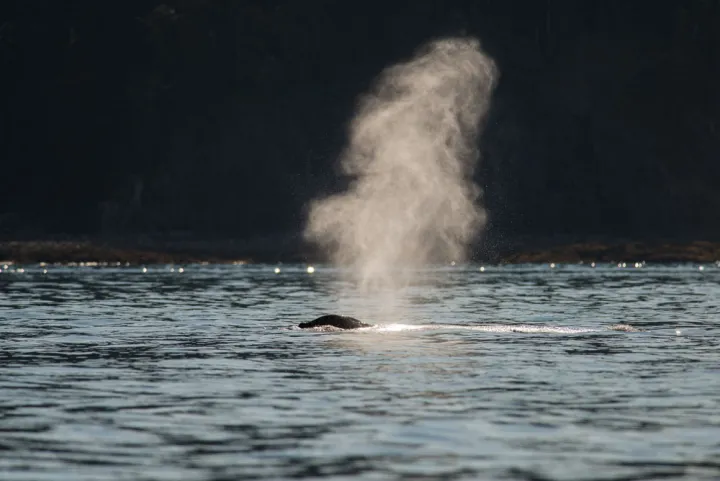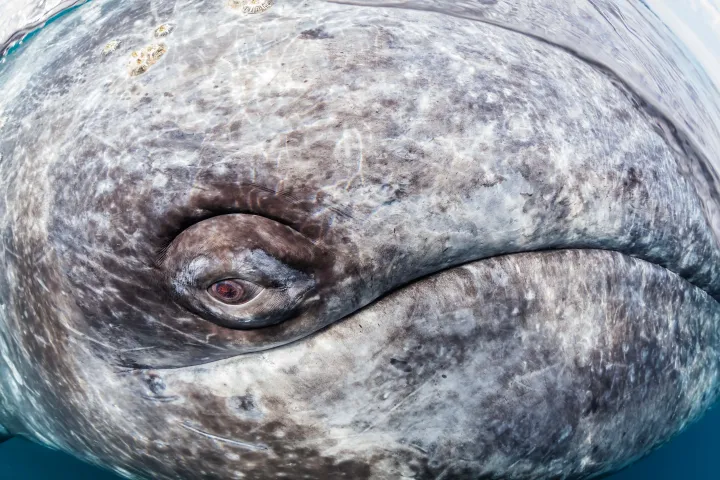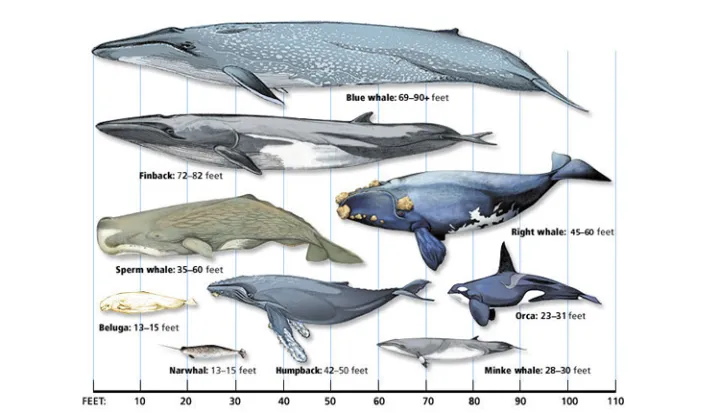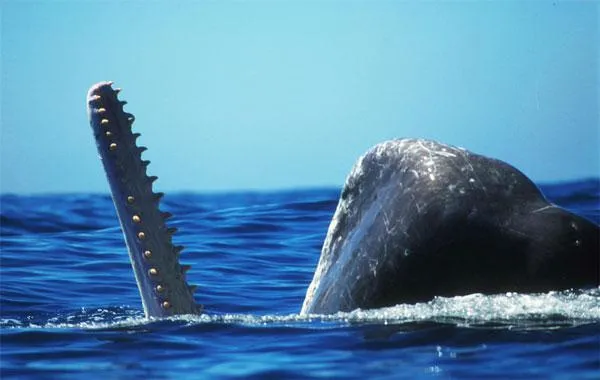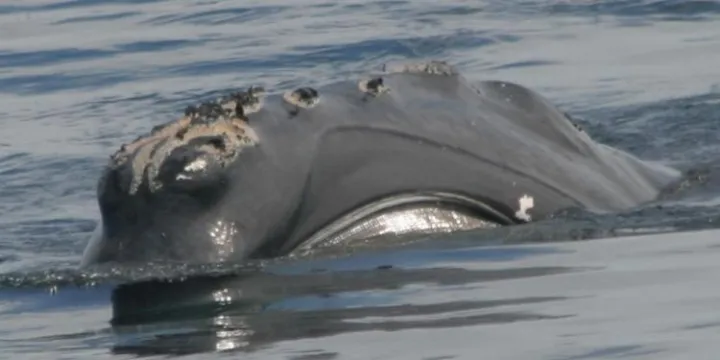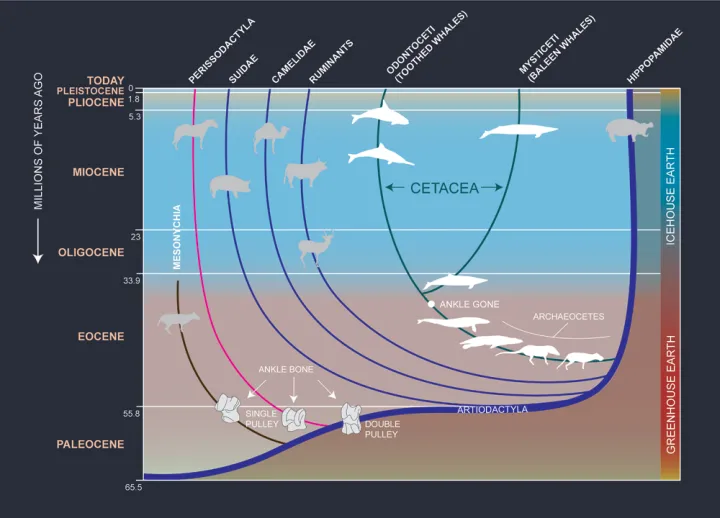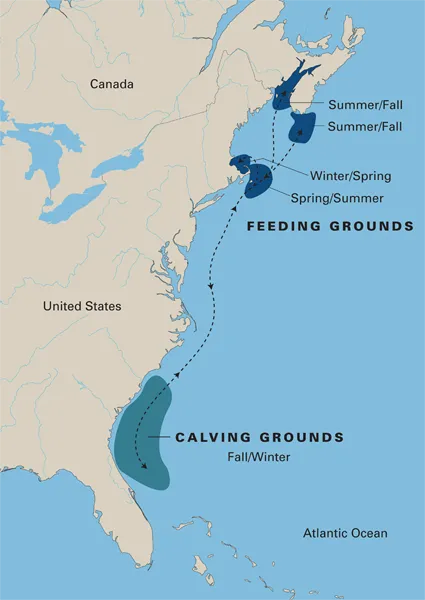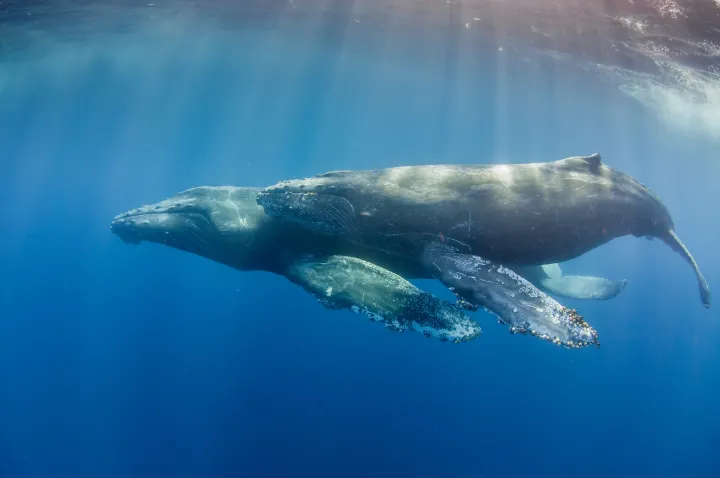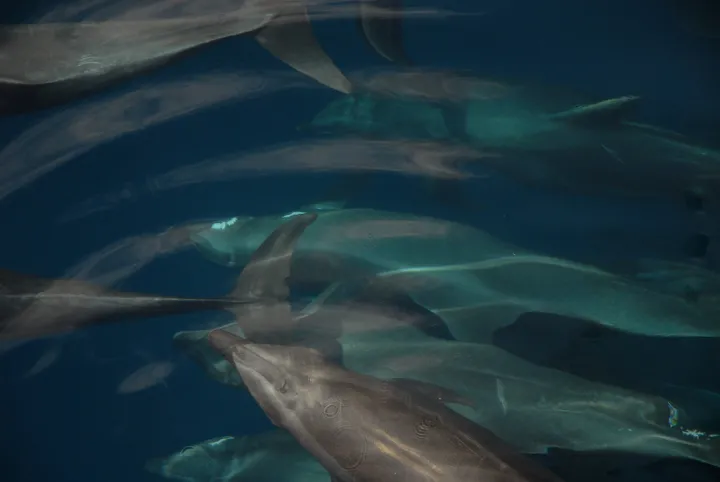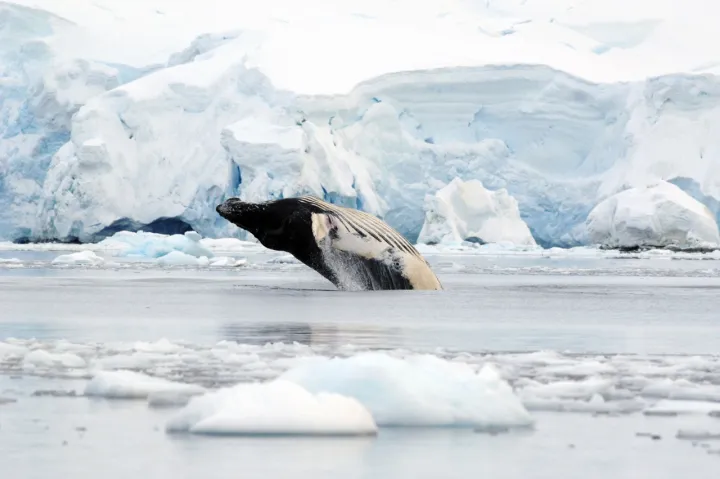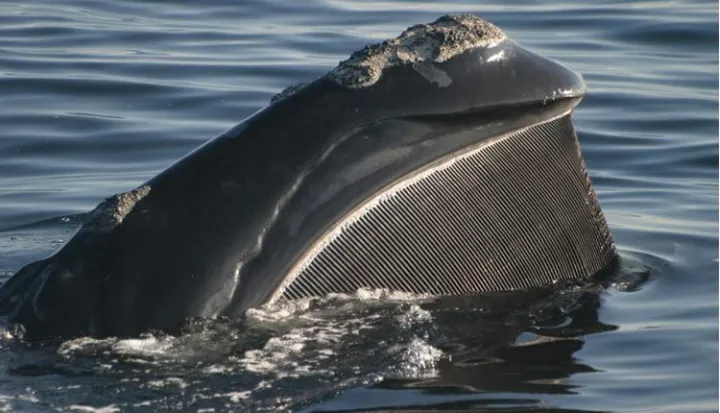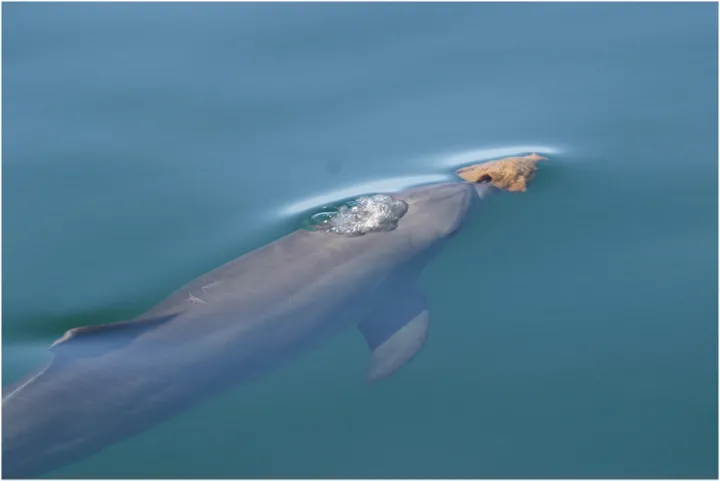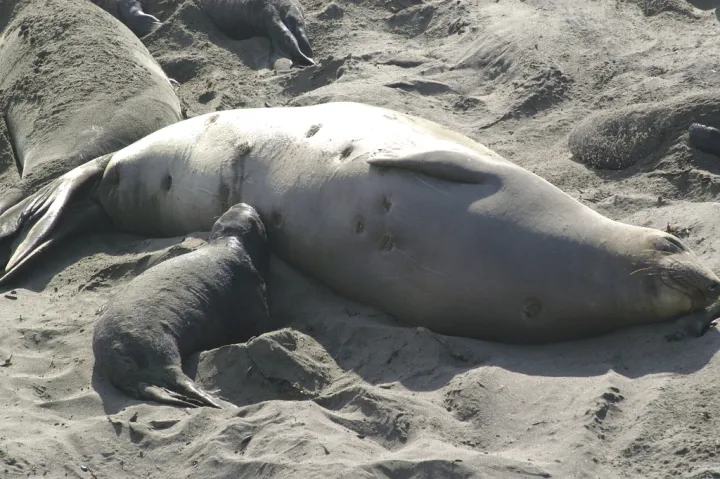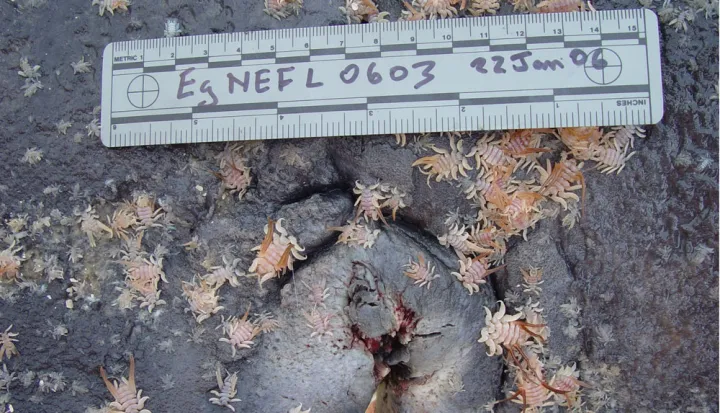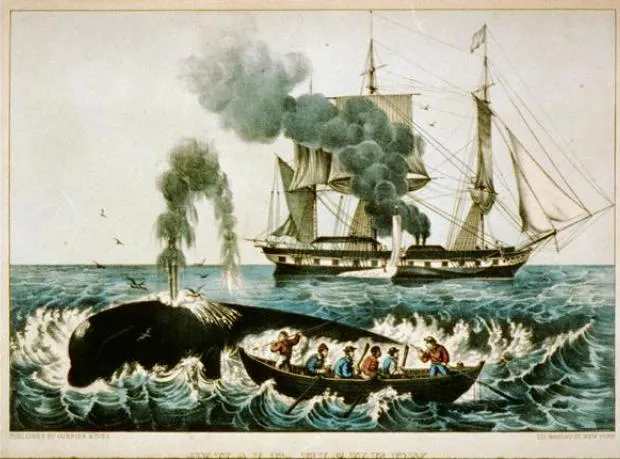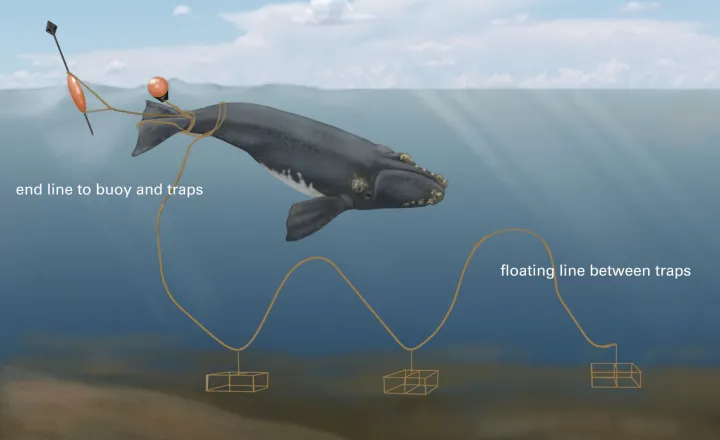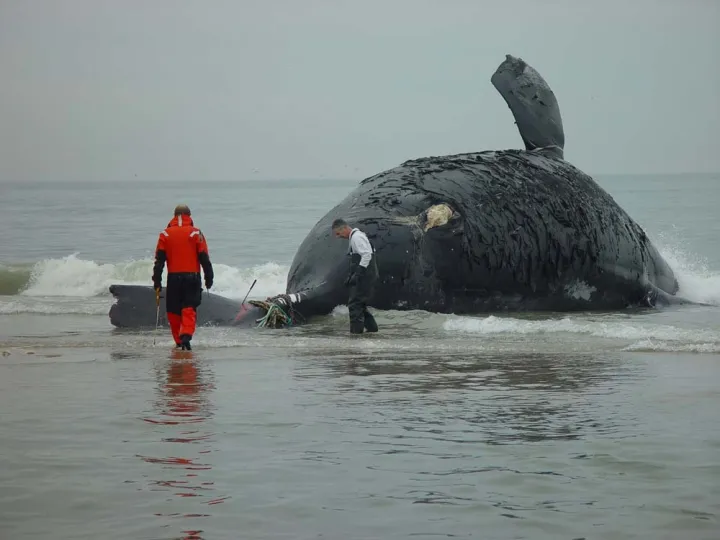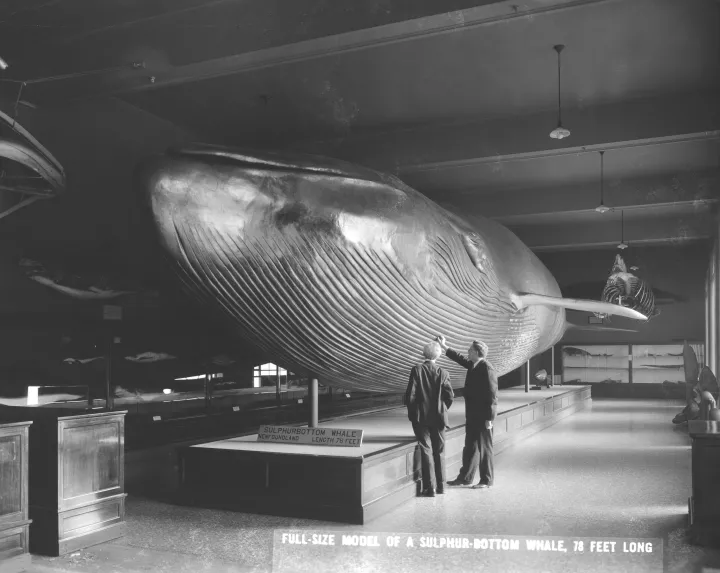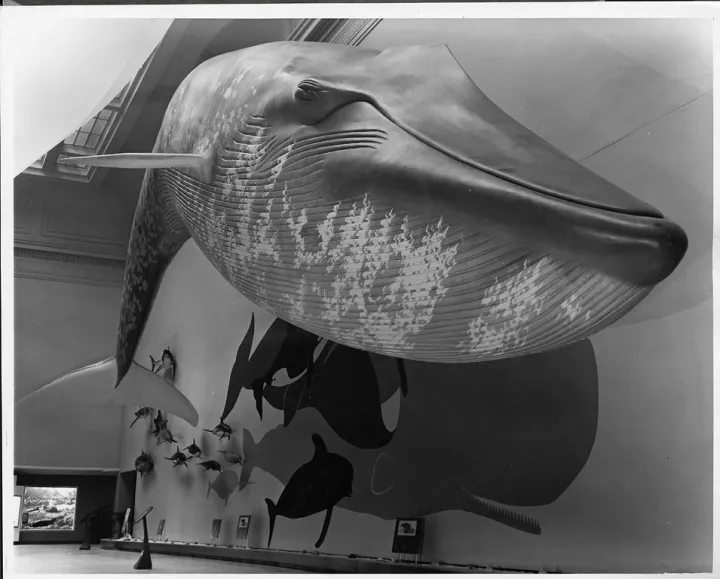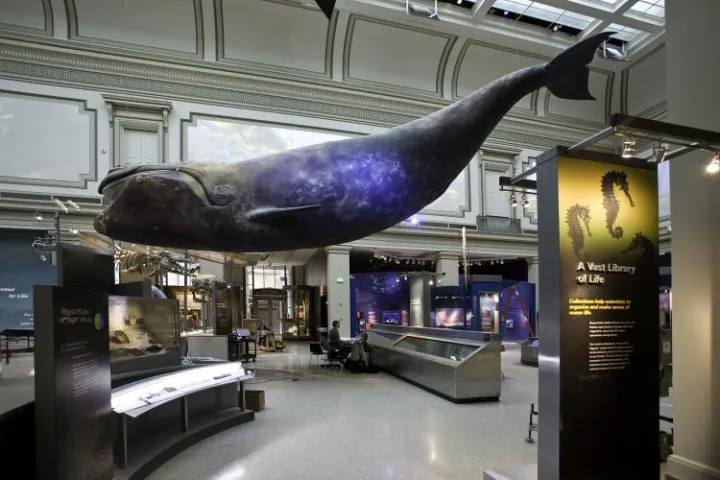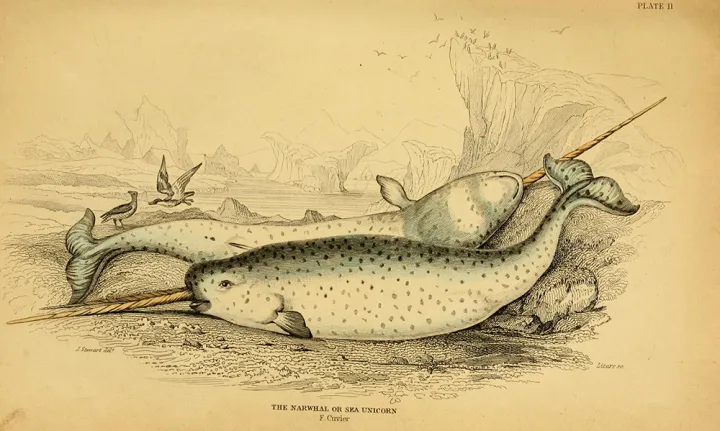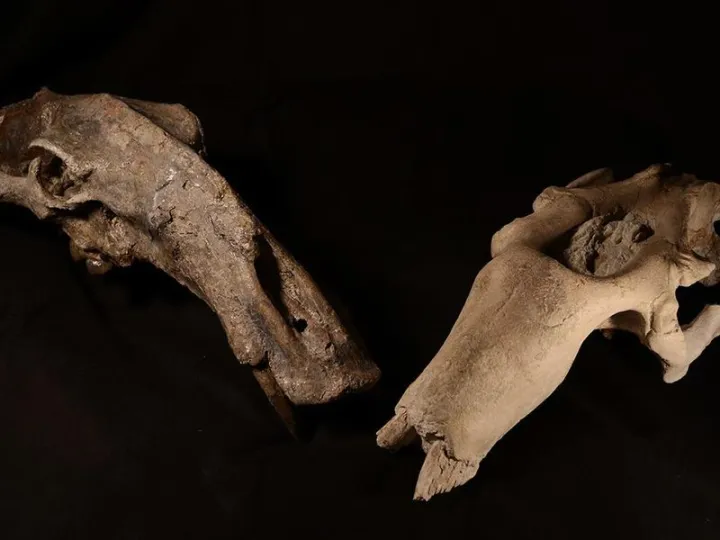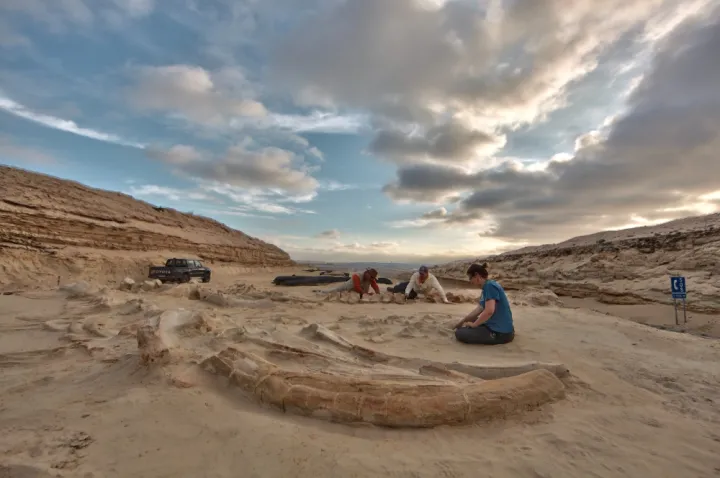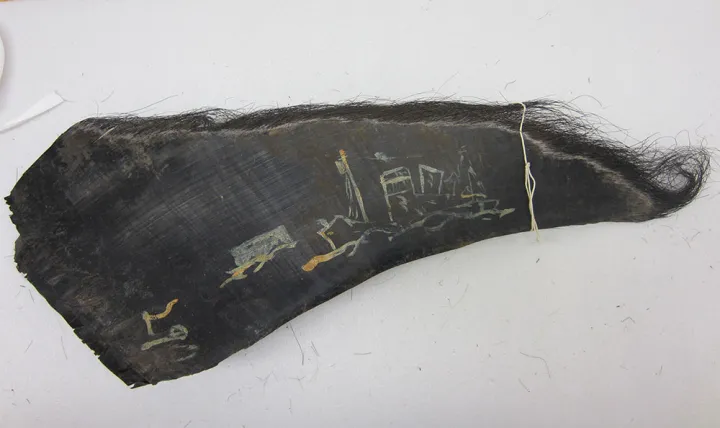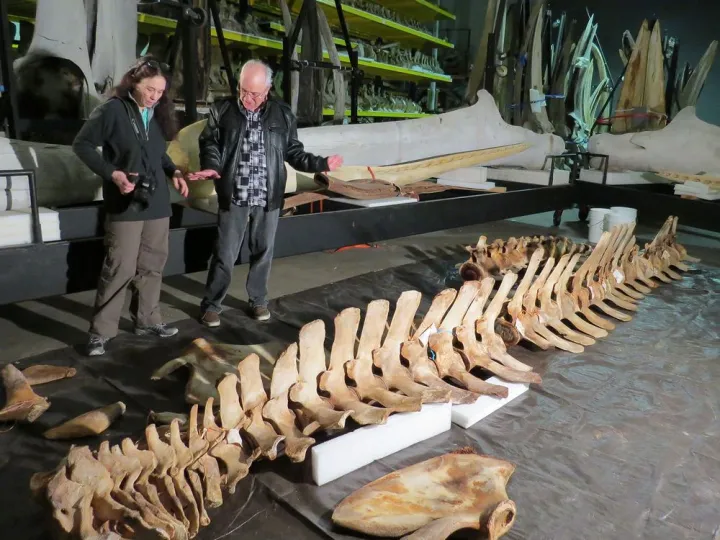
Whales and Dolphins
Introduction
When we think of whales, the enormous ones that filter tiny plankton from seawater with their baleen-fringed upper jaw often come first to mind (like the right whale in the picture above). But cetaceans also include dolphins, porpoises and other toothed whales, and in total contain more than 80 different species. They are found in all of the world’s oceans, and even in some freshwater rivers. Despite their very different diets and sizes, both baleen whales (Mysticeti) and toothed whales (Odontoceti) share a common (and perhaps surprising) ancestor—land-dwelling mammals related to today’s hippos that lived over 50 million years ago. On this page, we will generally refer to all cetaceans as whales, and in some instances specify when referring to traits or behaviors unique to toothed whales, baleen whales, or specific species.
Whales have always captured our hearts—the moans that come from humpback whales and the clicks from common dolphins remind us of our own human conversations. We even sent humpback whale songs into outer space with the spacecrafts Voyager 1 and 2, engraved on golden records for another civilization to decipher. We know that cetaceans are intelligent, but there is still so much to learn about how they think and communicate. Their long migration routes and deep dives mean that they are not easy to track. Despite the popularity of whale watches and long-term interest in protecting whales, even knowing something as basic as the number of whales over time is a challenging question to answer.
Are You An Educator?
Anatomy, Diversity & Evolution
Anatomy & Physiology
What Makes a Whale a Whale?
Whales are mammals which means that, like humans and other land mammals, they have three inner ear bones and hair, they breathe air, and the females produce milk through mammary glands and suckle their young. Mammals typically have hair to maintain body heat, but because cetaceans have insulating fat in the form of blubber they are often born with minimal hair that is lost as they grow older. They also share other characteristics with land mammals, but they have evolved numerous traits that allow for their full-time life in the water.
Body Structure
Whales may be large, but their bodies are streamlined to help aid in efficient swimming. Cetacean flukes move vertically through the water (unlike fish that typically move their tails horizontally back and forth). Their flippers (or pectoral fins) are modified forelimbs with an immobile elbow joint and are used mainly for steering, whereas flukes help propel the animals forward. When present, the dorsal fin is helpful for stability and has no support in the way of bones.
Whales are able to survive in deep or freezing polar water because of a layer of fat, called blubber, covering their entire body underneath the skin. Blubber is much thicker than the fat found in other mammals. Blubber is also less dense than the seawater cetaceans swim in, similar to wetsuits used for surfing or diving, which gives the animals buoyancy and helps them float. Blubber thickness has quite the range—varying from two to more than 12 inches thick depending on the species. The thicker blubber doesn’t necessarily mean that an animal is more insulated from the cold though—its main purpose is providing the animal with nutrition stores through winter months when food is scarce.
Larger species also retain heat because their skin surface area is small compared to the size of their bodies. Smaller species make use of higher metabolism and a counter-current heat exchange system of blood vessels in their flukes and flippers to keep warm. This exchange allows for cold blood in the limbs to move from the animal’s extremities in veins directly along arteries carrying warm blood from the animal’s core, instead of losing heat at the surface of the animal’s skin. Their blood vessels are also able to constrict when an animal is in cold water, reducing the amount of energy needed to pump blood throughout the circulatory system and conserving heat.
In addition to large bodies, cetaceans have large brains—sperm whales currently hold the title for the largest absolute brain size on the planet. The brain to body size ratio is also important, and the only animals with a brain to body size ratio larger than whales are humans. The result is a capacity for complex behaviors and societies, especially in oceanic dolphins, including orcas.
Breathing
Both baleen and toothed whales breathe through blowholes (the whale’s version of nostrils). These are found on the top of their head and connect to their lungs. Because cetaceans only eat through their mouths, which is not connected to their lungs, they are able to reduce the possibility of drowning from water moving into their lungs while eating a meal. Whales belonging to the group known as Mysticeti (baleen whales) have two blowholes, while toothed whales (Odontoceti) have only one. Unlike humans who breathe automatically, whales have active control of when they breathe. Cetaceans have specific control over a muscle called the nasal plug that closes the passageway of the blowhole—it remains closed when they are diving and is opened when they reach the surface.
Air exchange through the blowhole at the surface is very quick, taking only a fraction of a second to exhale and then inhale to fill their lungs with air. Typically, whales will breathe several times before diving again and then can stay underwater for a period of time—usually 5-15 minutes. Sperm and beaked whales (both of which are kinds of toothed whales) can even last an hour underwater before coming to the surface for another breath.
The telltale spouts that are formed on the surface occur when whales expel warm air that meets colder air on the surface and condenses into small water droplets. These spouts are unique to the different groups and species in part due to the different shapes that form from either one or two holes, but also because of varying blowhole shapes and animal sizes. The variations allow biologists and recreational whale watchers to identify cetacean species from a distance if they see a spout.
Adapting to Water
Large lung capacity—the blue whale can hold an equivalent of 1,300 gallons of air—allows cetaceans to swim for long periods of time without coming to the surface for a breath. But, their respiratory and circulatory systems are also much more efficient than mammals on land. Humans can only absorb between 15 and 20 percent of the oxygen inhaled in one breath, but for whales that percentage jumps to over 80 percent, thanks to their blood makeup. When baleen and toothed whales dive, their heart rates slow down and higher amounts of myoglobin molecules in their blood allow for more efficient capture of oxygen. They are able to maintain more myoglobin due to special “non-stick” abilities that mean the surfaces of the blood cells won’t stick together and clog the bloodstream. Their streamlined bodies also help reduce the amount of oxygen needed.
Despite their need to come to the surface regularly to breathe, cetaceans are able to dive to significant depths. Orcas usually only dive for less than a minute to five minutes before surfacing again, but even so they are able to reach depths over 300 feet (or more than 100 meters). Sperm whales are able to dive for over an hour and to depths greater than 6,000 feet (or 1,828 meters). Cuvier’s beaked whale has been recorded diving to 9,816 feet (2,992 meters), equivalent to the height of the Empire State Building; that means that they are covering the distance of 16 football fields and have to deal with increased pressure the deeper they go. Sperm whales, Cuvier’s beaked whales, and bottlenose whales are all deep divers and (along with some other deep-diving seals) have certain adaptations that allow for high levels of pressure on their lungs, nasal cavities and other air-filled spaces. Because the whales aren’t breathing while diving (they are getting oxygen from stores in their blood) their lungs are able to collapse from the increased pressure, reducing the amount of nitrogen that makes its way into the blood stream and the risk of forming dangerous bubbles when returning to the surface (what SCUBA divers call the bends). They can also cut off blood flow to the extremities, keeping the oxygenated blood by the heart and brain. Other air spaces, like ear canals and sinuses, are lined with special tissues that reduce pressure.
Sleeping While Swimming
How do whales and dolphins get any sleep while swimming? They have several mechanisms that prevent water from flowing into their blowholes (see Eating and Breathing section) even while they sleep. But, whales have to consciously go to the surface and breathe, so they aren’t able to entirely shut down their brains for some shuteye. Dolphins will shut down half of their brain for short durations of time while they continue to swim and breathe with the opposite hemisphere functioning and keeping an eye out for danger. (Literally, one of their eyes is open at all times!). They will continue to switch the side that gets rest until they get a full night’s sleep, of around eight hours. Whales will also rest in a semi-conscious state with the orientation of their bodies either vertically or horizontally, typically in groups. Logging behavior is a rest state for whales and dolphins when they are at the surface. They don’t move and resemble a floating log.
(For information on cetacean vision and hearing see the Behavior section.)
Senses
SOUND PRODUCTION AND HEARING
Like other mammals, all whales can produce sound using a larynx, an organ in the throat. In baleen whales, between the blowhole and the lungs there is a special larynx called the U-fold that directly connects to a unique, expandable sac within the whale’s chest. When the whale “talks,” air flows from the lungs, through the U-fold, and then fills the sac. The vibrations made by the U-fold reverberate within the air-filled sac, a system that allows these whales to create a sound loud enough to travel thousands of kilometers. Whales can also sing as they expel air from the sacs back into the lungs, a process that recycles the air and eliminates the need to exhale.
Hearing involves the perception of vibrations and underwater sound vibrations cause the entire skull to vibrate, not just the membranes in the ears. This is why sound underwater sounds garbled to humans. Over millions of years, whales have evolved floating middle and inner ear bones that are separate from the skull as a way to hear more clearly. The ear bones that house the middle ear are actually separate from the skull, housed in a suspended chamber of the skull surrounding the ear bones. Hearing is important for both baleen and toothed whales, but the mechanisms they use to take in and interpret sound may be different.
Toothed whales receive high-frequency sounds through specialized “acoustic fats” that sit along their lower jawbone and lead to their internal ears. They use echolocation, or biological sonar, to navigate and “see” objects. Toothed whales can expand their sound repertoire into the high frequencies through the use of nasal air sacs and a fatty melon that sits within their forehead. As air moves through the air sacs via the nasal passage it vibrates small fat bodies that create sound; this sound then passes through the melon, which likely acts as a kind of acoustic lens to focus the sound, and its direction. The whale can change the shape of the melon to produce different sounds. This is how they can add complexity to the high-frequency sounds used in echolocation. Toothed whales then hear the echo of this sound through fat bodies lodged inside their lower jaws; fat transmits the high-frequency sound to their ear bones, which the whale’s large brain then processes to give a view of the world, and the objects in it, through sound.
Baleen whales specialize in hearing low-frequency sounds for long-distance communication. They also have fatty tissue that seems important to their hearing, but the specific mechanisms are not well understood. Smithsonian scientists are exploring how these two groups come to have such different ways of hearing.
In all whales, the ear canal is plugged by a dense wax, which can tell us a lot about the life history of the whale it comes from. Unlike most mammals, whales do not have external ear flaps.
VISION
The physics of light control how vision works. On land where light is abundant, humans see the world using three specific color receptors. But underwater light is filtered, and in deeper water, many wavelengths are lost so that colors lose their vibrancy, fading altogether at deeper depths. Whales, adapting to this environment, only have one color receptor—they see in greyscale, which allows them to see better in the low light and they have large pupils to allow as much light in as possible. However, the murky waters of the Ganges have proven too dark for the river dolphins that live there. Over time they have lost their vision altogether—with no lens it is thought they still use the eye to perceive light—and instead rely on echolocation to navigate and hunt for prey.
Whales have also adapted the shape of their eye to better see underwater. Terrestrial animals, including humans, rely on the cornea—the clear outer layer of the eye—to focus images using a property called refraction, a bending of light as it crosses through different materials. As light travels through the air and enters the eye, it bends and creates a focused image on the retina with a bit of help from the lens. Underwater, terrestrial animals become far-sighted because the fluid of the eye and the water are so similar; light doesn’t bend enough and the image doesn’t focus effectively. To make up for this, a whale instead relies entirely on its lens to focus an image—which isn’t very effective. Whale lenses are circular to help focus, while ours are slightly flattened.
A whale’s vision is further differentiated from ours in that they have an eye on either side of their head, resulting in two distinct fields of vision, but as to how whales combine the two into a cohesive image, scientists are still unsure. Some species with more narrow face shapes, such as dolphins and beluga whales, can see with binocular vision—where they stitch together a single image, the way humans see.
Diversity
Toothed versus Baleen Whales
ODONTOCETI
The most species-rich group of whales alive is today are the toothed whales, or Odontoceti. There are over 70 different species that are found from cold Arctic waters to warm tropical ones. The odontocetes include dolphins and porpoises, as well as the larger beaked and sperm whales, as well as river dolphins. The group includes many extinct lineages as well, which represented different types of extinct toothed whales that in some cases still have close relatives, while in others represented uniquely extinct groups.
Sperm whales (Physeter macrocephalus) are the largest of the toothed whales, reaching up to 66 feet (20 meters) long. Vaquita (Phocoena sinus), Hector’s (Cephalorhynchus hectori) and Maui’s (Cephalorhynchus hectori maui) dolphins are among the smallest toothed whale species, each reaching less than 5 feet long. Narwhals (Monodon monoceros) are known for their long unicorn-like tusk, which is a modified canine tooth. They are most closely related to the iconic white beluga whales (Delphinapterus leucas), which are in the same family.
There are almost 40 members of the family Delphinidae, and some taxonomists consider it a bit of a grab-bag. These are the oceanic, or true dolphins, and include bottlenose dolphins (Tursiops truncatus), spinner dolphins (Stenella longirostris), pilot whales (Globicephala spp.), orcas or killer whales (Orcinus orca) and false killer whales (Pseudorca crassidens). In this overview, we will refer to Orcinus orca as orcas. Dolphins are known for their streamlined bodies, an elongated rostrum (or beak), and a curved dorsal fin. Orcas are the largest members of the dolphin family.
Porpoises belong to the family Phocoenidae, of which there are six members. Porpoises have stouter bodies and shorter beaks than the true dolphins and are typically smaller, with triangular dorsal fins.
Sperm whales, pygmy sperm whales (Kogia breviceps) and dwarf sperm whales (Kogia sima) make up the Physeteroidea group. The large heads of whales in this superfamily are where you can find the spermaceti, an organ used for communication and echolocation (see more in Echolocation and Communication sections). Male sperm whales are the largest of the toothed whales, reaching lengths of 60 feet, while the females only reach an average of 36 feet. This phenomenon, when the sexes are physically very different, is referred to as sexual dimorphism and this type of size difference among the sexes is found in many whale species.
Beaked whales are some of the most enigmatic of the toothed whales, spending much of their time in deep water—the Cuvier’s (Ziphius cavirostris) and Baird’s (Berardius bairdii) beaked whales can dive to depths of more than 1,000 meters.
MYSTECETI
The filter-feeding baleen whales belong to the Mysticeti group of whales. This group has fewer species today than odontocetes—there are only 14 living species of baleen whales, belonging to four families. The Balaenopteridae family (also known as the rorquals) has the largest number of species and include blue whales (Balaenoptera musculus), the largest vertebrate that has ever existed. Blue whales can reach lengths of over 30 meters (98 feet) and weigh over 190 tons. Right whales include North Atlantic right whales (Eubalaena glacialis), their near relatives North Pacific right whales (Eubalaena japonica) and Southern right whales (Eubalaena australis). Other baleen whales include the enigmatic pygmy right whales (Caperea marginata) that live today only in the Southern Ocean and gray whales (Eschrichtius robustus). Pygmy right whales reach only about 20 feet in length, making them the smallest of the baleen whales.
Generally, baleen whales are also found throughout the world’s oceans, and they are named for the plates of baleen in their mouth that filter out food from large gulps of ocean water (see Feeding section). Female baleen whales tend to be larger than males of the same species, another example of sexual dimorphism.
Evolution
A Move to the Sea
The fossil record of whales helps scientists understand how the whales we know today have evolved over the past 50 million years, since the time of the earliest whales that lived on land. The earliest fossil whales, such as Pakicetus, walked on four legs and foraged in rivers and estuaries for fish around 50 million years ago in parts of South Asia that today belong to Pakistan and India. Over the next five to ten million years, the earliest whales diversified into a variety of extinct lineages that experimented with different kinds of specializations for living in the water: some looked more like today’s crocodiles, others looked more like sea lions or otters. Some of these species, such as Maiacetus, likely had webbed feet and could move through the water propelled by a strong tail, although their tails likely did not have a fluke.
These first relatives of whales had many characteristics of land mammals—hind legs, nostrils for breathing near the front of their nose, and teeth of various sizes (as opposed to baleen or teeth of a single size, like modern whales have). Around 40 million years ago, early whales such as Maiacetus and Peregocetus, a recently described fossil whale found in Peru, possessed weight-bearing hind limbs. These fossils preserve the ankle bones, including a bone called the astragalus, which has a double-pulley structure like other even-toed hoofed mammals, such as cows, camels, pigs, deer, and hippos.
Around 40 million years ago, the first fully aquatic whales, such as Basilosaurus appeared. These whales had reduced hind limbs that could not support their weight on land, and they had elbow joints in their flippers. Small hind limbs show the Basilosaurus’ link to its land predecessors, but its inner ear shows more similarities to the modern whale. Whales today still bear the marks of their ancient land ancestors—they retain tiny remnants of hind leg bones in their hip region. Fossils of Basilosaurus were found in the United States in 1840s, and the Smithsonian has displayed a skeleton of this early whale since the late 19th century. A complete skeletal mount of Basilosaurus can be seen on display today in the Sant Ocean Hall.
Follow the Food
But why did these land animals move to the water? Since the end of the Cretaceous period when large marine reptiles went extinct in the Cretaceous–Paleogene extinction event, the oceans were absent of major predators (except for sharks). This left a large gap, allowing for mammals—including the earliest ocean-going whales in the Eocene—to evolve and take advantage of new opportunities, such as in the ocean, where food was abundant. Equally, the earliest whales may have experienced pressures from other predators on land, or they returned to the ocean for reasons that we cannot fully test.
By the end of the Eocene, the earliest four-legged whales had gone extinct, and the descendants of the first fully aquatic whales, such as Basilosaurus, diverged into the two main groups of whales we see today: baleen whales (mysticetes) and toothed whales (odontocetes). The oldest mysticetes did not have baleen and probably were not filter-feeders. The oldest known fossil mysticete, Mystacodon selenensis, from Peru, lived about 36 million years ago, which means that the divergence between baleen and toothed whales happened before this time. (The oldest fossil toothed whale is Simocetus rayi from Oregon, which is housed in the NMNH’s Department of Paleobiology, and roughly 33 million years old). In 2018, researchers from NMNH and other institutions described Maiabalaena nesbittae, a fossil mysticete that fed with neither teeth nor baleen, and instead likely sucked its prey into its mouth, as other toothed whales, such as beaked whales, do today. Overall, the ancestors of today’s mysticetes and odontocetes were smaller than the extremely large sizes of some species today—they ranged roughly between the size of a bottlenose dolphin to the size of a killer whale.
Ecology
Distribution
Cetaceans are ubiquitous in the ocean—they are found in shallow and deep water, cold and warm currents, from pole to pole, and the tropical latitudes in between. There are even whales that live completely in freshwater ecosystems. Some whales undertake great migrations depending on their needs. Many whales move to warm waters to mate and give birth in the winter, and then to colder waters in the summer where there is an abundance of food. These whales swim thousands of miles over several months, moving at around ten miles per hour, and even slower speeds when they are feeding. Dolphins and other toothed whales migrate as well, although their distances tend to be shorter than the larger baleen whales. However, not all whales migrate. Bryde’s (pronounced broodus) whales (Balaenoptera brydei) stay exclusively in warm tropical waters, and the extremely endangered vaquita can only be found in the northern part of the Gulf of California.
With the large size of baleen whales, one would think tracking their movements might be an easy endeavor, but this is harder than you might imagine. Although the migration patterns of some species are well known, others still prove elusive. For example, Southern right whales breed and nurse newborn calves in warm tropical waters off of South Africa, Australia, and South America, but scientists aren’t positive of their winter feeding ground locations.
Some dolphins and porpoises live closer to shore, making them easier to track. Two of the three recognized species of bottlenose dolphins—the Indo-Pacific bottlenose dolphin (Tursiops aduncus) and the Burrunan dolphin (Tursiops australis)—tend to spend most of their time in coastal near-shore habitats. However, the common bottlenose dolphin (Tursiops truncatus, familiar to most from the TV show “Flipper”), can be found as two separate populations that spend their time either offshore or close to the coast. The more coastal dolphin population tends to be smaller in size and lighter in color. Porpoises tend to live close to shore; the harbor porpoise (Phocoena phocoena) lives in coastal waters and can be seen swimming in shallow harbors and bays. Dolphins and porpoises will travel to warmer waters when faced with cold temperatures, but not on the same long-distance scale that you see with larger whales.
Population Size
Just how many cetaceans currently exist in our ocean, by species or population size, is a challenging but important question for scientists. Not only is it helpful to determine how many individual whales there are currently for conservation and management reasons, but population trends are also important in establishing an accurate baseline for any changes that happen over time, including population crashes or growths. To measure the current population size in cetaceans, scientists rely on a number of different methods. The International Whaling Commission, an internationally recognized organization that regulates whaling and organizes scientific discussions about whale conservation, has population estimation guidelines that use visual cues from ships and airplanes. Estimates can also be made using underwater acoustic recordings, mark and recapture methods, and visually identifying individuals based on their marks and scarring. Species found in the open ocean, rather than coastal ecosystems, are harder to study and therefore less is known about their life histories and population status. We know very little about beaked whales that spend much of their time in cold, deep waters, for example, and have few markings that identify individuals when they are seen.
Not only are estimates of current whale populations important, but past, pre-whaling population estimates help scientists to better understand how (if at all) whales have recovered from large-scale population declines. One study estimates that three million whales were slaughtered during the advent of commercial whale hunting. Estimating whale populations before large-scale commercial whaling depleted their numbers in the 19th century is particularly difficult. Scientists use historical whaling records or genetic methods (comparing genetic diversity within current whale populations) to determine past population sizes.
Breeding
Cetaceans reproduce through internal fertilization. Typically, mating happens during specific seasons and in specific ocean regions—for most baleen whales that means mating and birthing in warm tropical waters in the winter (see Distribution section above). Orcas and other toothed whales are thought to mate throughout the year. Different species show various courtship behaviors, and both females and males will mate with several different individuals to increase their chances of reproductive success.
With fewer than 450 individuals left, North Atlantic right whales are considered endangered and until 2013, researchers were unsure where they mated. In 2014, researchers determined that this species gathered to reproduce in waters off the Gulf of Maine during the Northern Hemisphere winter. The species can be seen in groups at the surface of the water nuzzling, rubbing, and generally jostling for a mate, in what researchers think is courtship behavior. Dolphins also show signs of courtship behavior, sometimes crossing over to aggressive mating behavior, and sexual behavior unrelated to reproduction.
Similar to humans, female cetaceans have long gestation periods, typically ranging from 10 to 17 months. Females usually give birth to one calf at a time and have a small number of young over their lifetimes. The calf usually is born tail first, although earlier in whale evolutionary history, cetaceans gave birth like other land mammals—fossils of the extinct whale Maiacetus show that they gave birth headfirst (you can see a skeleton of Maiacetus in the National Museum of Natural History Sant Ocean Hall). It is unclear when whales first evolved tail-first birth, but it likely happened when they moved from land to the sea (see Evolution section above). For modern whales, the mother often helps the calf get to the surface of the water for the calf’s first breath and then continues to help it by deterring predators. Once a cetacean mother gives birth she feeds thick, nutrient-rich milk full of protein and fat to her young. Once a calf is born and nursing it will stay with its mother for six months to two years. This energy-demanding time means that whales often won’t have another calf for several years. Cetaceans grow quickly after birth—a blue whale calf can grow 100 pounds a day. Although the young grow quickly, it takes years for them to reach sexual and social maturity (ten years in the case of most baleen whales).
Life-span
Cetaceans lead long lives, but because they are difficult to track and research, the specifics of their life spans are a bit muddled. Most are thought to live at least 20 years, and some species much longer. Bowhead whales can live 200 years, fin whales live close to 100 years, and most toothed whales live for 20 to 60 years. Captivity may significantly reduce an animal’s lifespan. One study found that only 27 percent of captive orcas live to age 15—in the wild 80 percent reach the same age.
Gaining information about the age of a whale or dolphin is difficult for scientists. Information can be gathered from dead animals that wash up on shore, or from bones that have been sitting in museum collections since the time of whaling. To learn the age of living whales researchers have turned to some surprising parts of the animal—earwax and skin cells. Whales gain earwax fairly consistently, adding layers throughout their life like tree rings. This allows researchers to age a whale and simultaneously see what sort of pollutants they are exposed to throughout their lives.
Behavior
Communication
Whales live social lives, and to recognize one another, coordinate group activities, and maintain contact over long distances, they’ve developed a complex system of communication. This range of signals includes pulsed sounds, whistles, songs, low rumbles, and body language that conveys different emotions. Belugas are especially vocal, and because of their cheery chirps they have been nicknamed the “canaries of the sea.”
The vocalizations of bottlenose dolphins are some of the best studied among cetaceans. They use a diverse array of whistles, and in some places around the world “pops” and “brays.” Each individual also has a personal whistle, similar to a name, that it uses to broadcast its identity and location. These “names” are learned and developed when they are young. Dolphins can also learn the signature whistles of others, and will call back and forth to one another when they meet.
Both orcas and sperm whales use group-specific calls that help them communicate with individuals in their social group. For orcas, calls are often used to identify one another and coordinate unified hunting. Sperm whales also produce a series of sounds that are unique to their specific social group. These codas, as they are called, are a series of rhythmic clicks with a broad frequency that the whales use during socialization. It is thought that mothers pass certain coda dialects to their young, allowing a coda to be transmitted through time from generation to generation.
For many baleen whales, including the bowheads, blue, minkes, and fin whales, communication occurs in the form of a song. The most complex whale vocalizations come from humpback whales which will sometimes sing for hours at a time. Each humpback song has a specific structure—the song is divided into up to eight themes, which are then further divided into phrases. A phrase is composed of individual sounds like rattles, whistles, moans, and grunts. Whales in one area will usually sing the same song, although it often will change gradually over time. But sometimes migrating whales will cross paths, prompting one set of whales to switch to the more popular tune. Scientists liken this phenomenon to a cultural revolution. As to why humpback whales sing? Scientists are still unsure, however, many hypotheses propose it has some benefit for mating.
Getting Social
Whales, for the most part, are social creatures. The majority live in small-to-medium-sized social groups for at least some part of the year. Whales will often congregate for specific activities, which include breeding, traveling, feeding, or rearing young. Oceanic dolphins form unusually large groups, congregating in schools of over a thousand individuals. At the other end of the spectrum are the river dolphins, who live solitary lives, only meeting up to mate.
The social networks of cetaceans can help to transfer information. In 1980, humpback whales were observed using a new feeding technique that added a slap of the tail at the surface. It turns out that the whales were switching from herring to the more populous sand lance, a fish species that was less affected by the bubble nets. But a resounding slap of the tail seemed to send the fish into a panic and bunch together, making the bubble nets more effective. By 1989, about half the Eastern humpback populations were using the trick and the whales were learning it from their peers.
Sperm whales are some of the more social whales. Pods consist of roughly 20 to 50 individuals, and at times several pods join to create massive groups of up to 100 individuals. Pods can consist of just males, just females, or a combination of both. This grouping behavior was exploited for whaling during the 1800s.
The group dynamics of Pacific Northwest orcas are particularly well studied. These whales live in family groups of between two and 50 individuals. Some of the pods are residential, meaning they have a home territory, while other pods are transient and move from place to place as the seasons change. These two types of orcas even differ in what they like to eat. Resident whales predominantly eat salmon, while the transient groups eat seals, sea lions, porpoises, and other whales.
At the Surface
Whales are known for their surface antics—searching for a view of them at the surface is the basis for a booming tourism industry. Cetaceans need to spend a certain amount of time at the surface of the water to breathe air but, as those on whale watching tours know, they do more than just breathe there. While these marine mammals are at the surface catching a breath, they engage in many other behaviors for feeding and communication.
Larger whales typically come to the surface to breathe every 10 to 15 minutes, while the smaller toothed whales, such as dolphins breathe more often—several times a minute. When releasing a breath at the surface there is often spray that results from the warm air (along with some mucus) released into colder water, which condenses and forms a water spout (more details in Eating and Breathing section). These spouts vary in size and shape based on the species and can be used to identify a species from afar.
The large jumps that bring almost the entire body out of the water are called breaching. Why whales perform these leaps is still not entirely clear, but there are several possibilities ranging from a warning or courting other whales in a group, physically removing unwanted parasites, getting better access to air in rough seas or simply playing. Whales may jump once or do a series of jumps, but the more that occur the more energy is used. However, porpoising—leaping out of the water over and over—is an efficient means of travel that dolphins and porpoises use to reduce the amount of energy used swimming over long distances. Dolphins will also ride the waves near the bow of a ship, a behavior that many think is just for fun.
Many other behaviors like lobtailing (when the fluke, or tail, is raised and flopped down on the water), pectoral slapping (when the side pectoral fins are raised and flopped down) and spyhopping (when the whale pops out of the water vertically to look around at the surface) can be observed in cetaceans. These behaviors are seen in all cetaceans but more often in groups of larger baleen whales like the humpback, sperm, and gray whales. Their purposes vary depending on the species and the circumstances. For orcas, spyhopping is likely used to better see prey at the surface (PDF) or on floating ice.
In the Food Web
Feeding Mechanisms
Cetaceans are large animals that need to maintain enough energy to swim, reproduce, care for young and evade predators. To do this they have to ensure they get enough food. Baleen whales get their name from their feeding strategy. They use large plates of baleen to filter through thousands of gallons of seawater laden with prey for their meals. Hundreds of these plates are lined up in a row and attached to the whale’s upper jaw. The baleen is made of keratin, which is also what makes up human nails and hair. The keratin frays at the edges producing comb-like strands that help to filter out small animals. These large baleen whales (including the largest vertebrate on Earth—blue whales) eat some of the smallest creatures found in the ocean. Their baleen filters out water and captures krill (small planktonic crustaceans), other plankton and small fish. The whales tend to seek out high-density patches of prey to increase feeding efficiency.
Most baleen whales take their large gulps of seawater close to the surface—species such as rorquals lunge-feed in a single gulp, while right whales skim continuously with their mouths agape. Researchers have found that blue whales complete 360 degree turns while lunging with wide open mouths to align their mouths with the swarm of prey and get the most possible krill. A blue whale can eat as much as one ton of krill per day at the peak of feeding time in Antarctica and fit as much as 150 percent of its body weight worth of water in one gulp. Groups of humpback whales will band together when feeding. One whale will dive down and begin to produce bubbles in a circle below the surface of the water. The bubbles will merge together and rise to the surface, causing confusion and producing a de facto net that surrounds schooling fish they have encountered. Then, other whales will rise up through the center forcing the fish towards the surface where they are gulped like fish in a barrel. Bubble net feeding, as it’s called, is only seen in humpback whales during the feeding season. Gray whales, in contrast, feed close to the seafloor where they suck up prey in the muddy sediment that they filter through their baleen.
For toothed whales, it’s not one-size-fits-all either. There is a huge range of feeding behaviors largely based on a variety of tooth arrangements—teeth in toothed whales are mostly for seizing prey, not for chewing. Toothed whales mainly feed on single prey items, as opposed to baleen whales that filter tiny prey by the hundreds to thousands of individuals. Most dolphins have cone-shaped teeth, while porpoise teeth are flattened. Tooth numbers range from a pair, to dozens to hundreds.
Narwhals have two teeth, but in females they rarely erupt through the gums and in males only one typically does—growing into the long, unicorn-like protrusion for which they are famous. There are exceptions—occasionally females have erupted tusks; some males have two erupted tusks, and some none. Most beaked whales also have one pair of teeth, which tend to be tusk-like, and visible only in males, while the teeth in females stay hidden in their gums.
Most toothed whales feed on one prey item at a time, grabbing it and swallowing it whole. Dolphins and porpoises eat a variety of fish, squid and crustaceans, like crabs and lobsters. Dolphins use their beak and conical teeth, while porpoises have shorter mouths and squarer teeth, both allowing them to grip their prey—no need to chew. One population of dolphins has learned to cover their beaks with conical sponges to dig up fish hiding on the seafloor, a skill that is passed from mothers down to their offspring. Dolphins will also thrash octopuses at the surface as a way to stun them before they attempt to eat them. Beaked whales suck their prey into their mouths in order to swallow them. Larger toothed whales, like orcas, eat fish and cephalopods, but also sharks and larger marine mammals including sea otters, seals, sea lions and smaller whales. Different populations of orcas tend to make their meal choices based on their locations—salmon in waters off the Pacific Northwest, herring in waters off of Europe and minke whales in waters off Antarctica.
Narwhals have never been observed feeding, so what we know about their prey is only from research on their stomach contents. Their diet consists mostly of halibut, cod, squid and shrimp, and they tend to stock up on their food in the winter, making deep dives to find their prey. Sperm whales require a large amount of food—over a ton a day. To meet this need they eat all sorts of animals: octopus, fish, shrimp, and squid. Sometimes meals are made up of larger creatures—colossal and giant squid.
Finding Food
Baleen whales find prey by using a mixture of sound, sight and special reception organs. In 2012 researchers discovered a sensory organ in the bottom jaw of some whale species. Smithsonian scientist Nick Pyenson and his colleagues hypothesize that the organ helps blue, fin and humpback whales to take their giant scoops of water via lunge-feeding.
Toothed whales have another tool to find prey that baleen whales lack—echolocation. Odontocetes produce sonar pings that are sent out and echoes are returned when they hit an object, allowing the animal to better know its surrounding environment and what prey is nearby. Echolocation is quite exact and can help detect tiny size differences and even fish burrowed in the seafloor.
Predators
Most cetaceans have no natural predators. Baleen whales and larger toothed whales, like the orcas and sperm whales, almost never face predation from the sea—humans are their greatest threat (see Whaling section). Orcas occasionally will work together in a group to attack large baleen whales, primarily focusing on juveniles or weak, injured adults. There are instances of flesh being bitten off of whales by cookie-cutter sharks, but no recorded deaths from their bites. Sharks, walruses and polar bears sometimes consume smaller toothed whales. Although never observed, there is some evidence that sperm whales and giant squid engage in epic battles. It appears that the whales will eat the squid (their hard beaks are found in the whales’ stomachs) but from the giant sucker scars often found on the face and backs of sperm whales, it’s clear the squids fight back.
Parasites
Cetaceans include the largest living animals on the planet, but some of the smallest can be found living on and in whales, dolphins, and porpoises. Small crustaceans called whale lice live in folds and rough patches of their skin, as well as in their lesions and nostrils. Most whale louse species have an exclusive corresponding cetacean species that acts as the host for their entire life cycle. Male and female sperm whales even have different unique lice species that they host.
Barnacles mooch off of whales in a commensal relationship—hitching a ride on their backs. The barnacles don’t harm the whale but take advantage of the moving home that brings meals directly to them. Remora fish also take advantage of the ride, attaching to the large mammals with a modified fin. They don’t seem to harm cetaceans—research indicates that they likely help whales remove other external parasites, although any substantial benefit remains unclear. Some seabird and fish species that follow whales take advantage of these leftovers.
A large diversity of internal parasites also infest cetaceans. A variety of parasitic worm species can be found in the blubber, intestines, stomach, liver, and lungs of whales. One roundworm species lives in the placenta of sperm whales and reaches lengths of over eight meters, and pygmy sperm whales host a similarly long roundworm in the tissue under the whale’s skin.
Human Connections
Whaling
The first record of whaling dates back to 6000 BCE in Neolithic petroglyphs found in South Korea. Similarly, engravings that depict men pursuing a spouting whale show that by 2000 BCE the Norwegians had begun the practice of whaling. Evidence of early whaling also exists for people in Greenland, from the islands off of Japan, and residents of the Aleutian and Phoenician Islands. These early whalers predominantly used whales for food, fuel, and tools. To ensure bountiful harvests, they honored and gave thanks to whales in a variety of ways.
By the 11th century, harpooning whales was a way to get rich. At this time, Basque whalers of Iberia (Spain) hunted right whales, which later earned their common name because they have the right suite of traits for whaling, such as congregating near shore, being relatively slow-moving, having ample blubber, and floating after being killed. A single right whale could yield 5,247 liters (1,386 gallons) of oil plus 293 kilograms (647 pounds) of baleen. In Norway and Iceland, whalers would corral whales into fjords and then block their exit with nets. Spears were dipped in blood from previous hunts so that the wounds would become infected and eventually kill the whale. Among the most successful hunters were the Basques. They started hunting whales in western Europe in the 11th century using boats and harpoons and continued until whales in the region were depleted. Basque whalers then moved across the Atlantic to Labrador, where from 1520 to 1630 they hunted right and bowhead whales along their migration routes. By the 1600s those whale populations, too, had plummeted. So, the Basque fishermen turned to cod and seals.
In the United States, whaling did not reach its height until the mid-19th century. Known as Yankee whaling, the American industry dominated with 735 of the world’s total 900 whaling vessels in 1846. The U.S. alone killed more than 100,000 whales total during peak years, with sperm whales—especially those in the South Pacific Ocean—the primary target. Sperm whale oil was highly desired for its exceptional lubricating quality and ability to burn brightly and without odor. Sperm whales also contained a special liquid in their head called spermaceti or “head oil” and a wax-like substance in their intestines called ambergris that was used in medicine and perfume. Baleen whales, including gray, bowhead, humpback, and right, were also targeted despite having inferior quality oil. Their baleen was used in buggy whips, carriage springs, corset stays, fishing poles, umbrellas, and hoop skirts. Life at sea was long and arduous for whalers, and many filled the hours of idleness by taking up carving and engraving. Scrimshaw is a traditional, nineteenth-century pastime that included the engraving of whale teeth, bones, and baleen (also called whalebone), with decorative artwork.
In the 1860s a Norwegian entrepreneur revolutionized the whaling process and ushered in a new, modern era of whaling. Sven Foyn’s boats were steam-powered and equipped with deck cannons that shot harpoons that exploded on impact. The Norwegian whalers initially hunted close to home, but by 1904 they began to expand throughout the world, establishing whaling stations as they went. In the 1920s, they also introduced pelagic-factory ship whaling where the entire whale was hauled on deck to be processed at sea. Other advances included processing machinery, radio, the use of fleets with many specialized vessels, and aircraft spotting. Whaling became so efficient that by World War II many species were on the brink of extinction. Between 1900 and 1999 an estimated three million whales were killed by the whaling industry.
Today, most nations observe the whaling ban put in place by the International Whaling Commission (see Conservation section). Only a few nations, including Iceland, Japan, and Norway, object to the ban and continue to whale. The IWC also allows certain aboriginal groups from Canada, the U.S., Greenland, Russia, South-Eastern Asia, and the Caribbean to whale since it has been deemed an integral part of their nutritional and cultural life.
The documentary The Cove was instrumental in spreading awareness about a particular slaughter event that occurs in Taiji, Japan. Every March thousands of dolphins are secretly corralled in a particular cove. A few are selected and sold to dolphinariums and the rest are slaughtered and their meat sold in local supermarkets. Although it did spark an international outcry for a few years, the fishers of Taiji still capture and slaughter dolphins every year and the city is planning to turn one of the larger bays into a dolphin park and research facility.
Captivity
The first recorded cetacean in captivity was a beluga whale that lived in the Boston Aquarial and Zoological Gardens (PDF) in 1861. Later that year, P.T. Barnum (the eventual founder of the Barnum and Bailey Circus) displayed two beluga whales in the basement of his New York City American Museum (not the American Museum of Natural History), followed by at least nine whales that lived and died while on display by Barnum between 1861 and 1865.
Throughout the 1870s several aquariums in the United States and in Europe began to showcase particular whale species, such as beluga whales and oceanic dolphins, though few were able to keep them alive for very long. In 1938, Florida’s Marine Studios, initially built as a film location for underwater productions, was quickly reinvented into a tourist attraction once the owners discovered the dolphins’ theatrical talents. It wasn’t until the 1950s and 60s that people realized dolphins could be trained to perform elaborate tricks and routines. The U.S. Navy Marine Mammal program began in 1960 and studied the animals as well as trained them to help with military procedures. But the true popularity of viewing dolphins in captivity began after the release of the movie Flipper in 1963, and a subsequent TV show. Prior to the popularity of Flipper there were only three designated dolphin parks or dolphinariums—now there are over a hundred worldwide.
Although the first successful captures of an orca occurred in 1961 and 1964, methods had yet to be perfected and many whales died from entanglement or other injury. By the late 1960s two successful methods emerged, but even those could cause various trauma to the whales. By the 1970s, public awareness halted the capture of orcas off the coast of British Columbia and Washington, and in 1976 the last orca was taken from the region. Iceland then became the main source of whales for marine parks—between 1955 and 1972, 300 orcas were captured from Icelandic waters for the marine park industry. In later years marine parks resorted to breeding their captive whales, and in 2004 the first live births from artificial insemination occurred.
Life for a captive whale is very different than in the wild. Confined to small spaces, whales attack one another to assert dominance and the victim, unable to escape as they would in the wild, can become severely injured. Captivity can also lead to poor health. Male whales experience a condition called dorsal fin collapse. Although scientists are still unclear as to why this occurs, it likely is associated with structural changes in their collagen over time. The chemicals in pool water can cause health problems like blindness, and about half of captive dolphins die (PDF) in the first 90 days after they’ve been captured.
Today, the live dolphin trade is illegal in the United States, Mexico, and Europe, however, live dolphins are still captured in other countries to minimize inbreeding among the dolphins already in captivity.
In 2013, the release of the documentary Blackfish, a depiction of orca treatment at Sea World, changed the public’s perception of whales in captivity. Many people became upset by the revelations of the documentary, and attendance at marine parks has since dropped. Sea World has since ended the breeding of orcas in captivity.
Whale Watching
Whale watching is a popular pastime around the world. The enterprise first started in California in the 1950s and has continued to grow in popularity. In 2009, the industry generated around 2.1 billion dollars from 13 million whale watchers and supported 13,000 jobs.
The trend not only helps raise awareness about whale conservation by exposing people to the rarely seen creatures, but it also provides an alternative source of income for communities where fishing may not be as profitable as in years past. In Laguna San Ignacio on the Baja Peninsula, fishermen began supplementing their income in the 1980s by taking tourists to see the curious and friendly gray whales that come to the protective lagoons to rear their calves. Now, the whale tourism industry there is one of the most important contributors to the local economy. Marine tourism in Baja California Sur generates 300 million dollars a year and supports roughly 2,000 people. Only 16 boats are allowed in the lagoon at once, and fishing is suspended when the whales come for the season, a management strategy that hopes to ensure the whales will continue to return.
However, whale watching also has its downsides. The presence of whale-watching boats can alter whale behavior, including scaring them off from important feeding areas, and boat noise and pollution are other sources of stress. On occasion, a tour boat will collide with a whale, injuring or even killing it. According to data collected by the International Whaling Commission, whale-watching vessels collide with whales in the highest numbers compared to all other vessels. However, it is important to note this may be skewed by the likelihood of a vessel type to report a collision.
Books, Film & Music
For hundreds of years, whales have been described by seafarers as fearful beasts. Confined to observe whales from the shore, many influential writers and naturalists like Aristotle and Pliny had inaccurate information about whale behavior and anatomy. Dicuil, a monk and geographer among Charlemagne’s court in the 800s, wrote, “About, leap numerous whales as large as mountains, fed by the vast Red Sea. Over their back and shoulders runs a terrible spine, bringing death and fate beneath their savage mouths. They are wont to suck down both ship and crew alike.”
It is likely that these accounts influenced the stories we are familiar with today. In the Bible, Jonah becomes imprisoned in a whale’s stomach for three days, a theme that is mirrored in Disney’s Pinocchio from 1940. Herman Melville’s famous story of Moby Dick, published in 1851, also features a villainous sperm whale that Captain Ahab chases to enact revenge.
It wasn’t until recently that humans began to see whales as charismatic and intelligent creatures. It was a surreal experience for scientist Roger Payne when he first heard the haunting songs of humpback whales in the 1960s. According to Payne, “That’s what whales do; they give the ocean its voice, and the voice they give it is ethereal and unearthly.” The music industry agreed. In 1970 Roger Payne’s Songs of the Humpback Whale climbed music charts. Soon musicians began incorporating their haunting melodies into mainstream music, a trend that helped change the perception of whales from expendable commodities to charismatic creatures, worthy of protection. Whale song was even included on the Golden Record aboard the Voyager space probes that were launched in 1977.
Whales have since graced the big screen as friendly companions. The film Flipper, about an injured bottlenose dolphin, aired in 1963 and instantly became a classic, in addition to beginning a TV show. In 1993, the movie Free Willy, a story about the special bond between a young teenager and a charismatic, captive orca, captured young audiences and went on to become a successful series of movies. In the 2002 movie Whale Rider, a young Maori girl follows the path originally set forth for her brother to become tribe leader, using her special connection with Southern right whales to prove that she is worthy.
Myths & Legends
Mysterious creatures from an underwater world, whales have inspired many myths and legends across the globe. Peruvians from the Amazon believe drownings are caused by boto, the Amazon river dolphin (Inia geoffrensis), as a shape-shifter who transforms into the image of a beautiful man or woman to lure victims to their death. In China, the now-extinct Yangtze River dolphin (Lipotes vexillifer) is viewed as the reincarnation of a fabled princess. Refusing to marry the man chosen for her, the Princess of the Baiji is thrown into the Yangtze River and later emerges as the dolphin. In a similar Inuit legend, the Princess Sedna falls for the bird spirit, much to the dismay of her father. In an effort to hide her, the father takes her out to sea, but in outrage, the bird spirit creates a terrible storm. Forced to sacrifice his daughter, the father tosses her overboard. As the princess clings to the side of the boat he cuts off her fingers, and each finger becomes one of the sea mammals, one of which is the whale.
It may come as a surprise that the tale of the unicorn was most likely inspired by a whale. Historians think the first description of a horned horse comes from Greek physician Ctensias of Cnidus in 398 B.C., though it also finds its way into the Bible through a series of mistranslations. Then during the Middle Ages, Viking traders likely introduced narwhal tusks to European markets. Unfamiliar with this Arctic whale species, the existence of the narwhal tusk became proof of the unicorn. Evidence for this theory includes depictions of unicorns in artwork with a spiraled horn. The narwhal tusk is the only animal horn or tusk with such unique anatomy.
Conservation
All marine mammals in U.S. waters are protected under the Marine Mammal Protection Act, federal legislation that was enacted in 1972. Protecting cetaceans in international waters is more difficult. With an international ban on whaling in effect since 1986 (allowing for some exceptions) many whale populations have bounced back from low numbers. However, several species populations remain extremely low. In early 2020, fewer than 450 individual North Atlantic right whales remain and they are considered critically endangered, as are their sister species, North Pacific right whales, with fewer than 100 individuals remaining. The vaquita, a small porpoise found only in coastal waters of the Gulf of California off of the Baja Peninsula in Mexico is also extremely endangered, mostly because of getting caught accidentally in fishing gear. There are now less than 20 of these porpoises left.
Threats
Entanglement & Marine Debris
One of the biggest threats to whale survival is entanglement from fishing gear. Once made with biodegradable wood and ropes, fishing gear is now predominantly made of synthetic materials, like plastic. Gear often gets lost at sea and will continue to injure or kill animals whether they were the intended target for the gear or not, a phenomenon called “ghost fishing.” Over 300,000 whales die each year due to entanglement, a problem that can cause starvation, drowning, infections from cuts and deeper lacerations, increased risk of ship strikes, or increase the risk of becoming another whale or shark’s prey. It can also limit a female whale’s ability to birth young. Today, female right whales are giving birth every 9 years as opposed to every three years as they were in the 1980s, a trend that is likely not only influenced by entanglement but other stressors as well.
Consumption of plastic debris can also kill whales. Not only can the whales die from blockage of their stomach or intestines, sharp plastic shards can also pierce intestinal lining, and they can starve due to feeling falsely full from a stomach full of plastic with no nutrients. As filter feeders, baleen whales suck in large volumes of water to catch the fish and krill required to sustain their massive sizes, and discriminating between food and plastic is impossible. Toothed whales can also unknowingly consume plastic hidden within their prey. In 2019, a large sperm whale was found beached with over 200 pounds of trash in its stomach.
Shipping Vessels
Right whales live and migrate along coastal shores and so they frequently pass and congregate near bustling ports. They are also slow swimmers, a trait that has proven deadly in the 21st century. Between 1970 and 1999, 45 North Atlantic right whales were found dead in coastal waters of the U.S. east coast—and ships killed one-third of them. Other whales, like the fin whale, blue whale, and humpback whale, are also struck by passing ships. A study of humpback whales that live off the Gulf of Maine found that 15 percent of humpback whales in the region have injuries related to ship strikes. These findings prompted negotiations between the New England Aquarium, the National Marine Fisheries Service, the International Maritime Organization, and the shipping industry to move shipping lanes away from known whale congregation areas and to decrease ship speed limits.
In 2008, United States regulations were modified to limit the speed of larger ships to 10 knots (11 miles per hour) when at a distance of 20 nautical miles (23 miles) offshore during whale calving season, a time that changes according to the location along the coast. It seems as though the rule is limiting whale death caused by ship strikes. Between 2008 and 2013 only two right whales were killed by ship strikes within U.S. waters, and neither one was within 50 miles of the protected areas. Comparatively, ships killed 15 right whales between 1990 and 2008, and 13 of those were found in areas now protected by speed limits. Unfortunately, although this effort has reduced deaths caused by ship strikes, the right whale population continues to decline due to gear entanglements.
Noise Pollution
As humans continue to increase their presence at sea, it becomes a noisier place to live. Ship and submarine sonar pings, military tests and drills, seismic testing, the churning of boat motors, and drilling on oil rigs are just a sample of manmade noises that contribute to noise pollution in the ocean. Whales rely heavily on sound for communication, but in this new noisy reality they struggle to have their voices heard. Whale behavior is also harmed by the presence of human noise. Beluga whales were observed vacating a feeding area and swimming 50 miles (80 km) away for several days to avoid an approaching ice-breaker ship. Some Blainville’s beaked whales (Mesoplodon blainvillei) will stop hunting in the presence of navy sonar, and sperm and pilot whales stopped vocalizing during the Heard Island Feasibility Test of 1991, a study that aimed to determine how far manmade acoustic signals could travel in the ocean. Beaked whales and blue whales are particularly sensitive to sonar, and several mass strandings have been tied to related military exercises.
But there is cause to be hopeful. In an effort to reduce the impact of sonar on whales, the U.S. Navy agreed in 2015 to end mid-frequency sonar training in specified areas where whales congregate, and in 2016 they extended the exclusion to low-frequency hunting sonar. In waters near British Columbia, Canada, a voluntary speed reduction policy during the season when endangered orcas migrate through Haro Strait was put in place for the first time in 2017. The initial policy successfully decreased noise pollution from commercial ships and was continued in 2018.
Successes
In 1946, the International Whaling Commission (IWC) was formed to “provide for the proper conservation of whale stocks and thus make possible the orderly development of the whaling industry.” The commission’s main duty is to govern whaling practices around the world. This work includes completely protecting certain species, designating sanctuary areas, setting catch limits for specific species, deciding on appropriate whaling seasons, and prohibiting the capture of mothers with their calves. But as whaling populations continued to decline, the Commission evolved to fill a conservation role. In 1982, the IWC officially banned commercial whaling, however, aboriginal whaling and the issuance of scientific whaling permits are still allowed.
Because of these efforts, in 2016 most humpback whale populations were removed from the endangered species list. Only the population that breeds in Central America remains on the list, and the California blue whale population is also making a comeback. In 2014, a study determined that this subset of blue whales is at about 97 percent of what it was prior to whaling, offering hope that other whale species and populations, with continued protection, can rebound.
At the Smithsonian
Since 1850, whales have found a home at the Smithsonian Institution. At that time Spencer Fullerton Baird was a curator and avid naturalist who made whale research a top priority for the Institution. In 1871, he convinced Congress to create the Commission of Fish and Fisheries, the precursor to today’s National Marine Fisheries Service and the U.S. Fish and Wildlife Service. The agency was run by Baird himself, in addition to his other duties at the National Museum (what is now the National Museum of Natural History), and later when he was elected as Secretary of the Smithsonian in 1878. While Baird was at the Museum he acquired many marine mammal specimens, including those from the U.S. Exploring Expedition of 1838 to 1842.
Today, the museum’s whale collection includes over 30,000 specimens, the largest in the world. The museum is also home to Phoenix, a 45 foot, 2,300 pound full-scale model of a female North Atlantic right whale that hangs in the Sant Ocean Hall. She is one of many whale models that have graced the halls of the Museum, including the 1903 blue whale that was the first-ever cast of a whale, and the 1963 blue whale that replaced it.
Today, the National Museum of Natural History has two curators who specialize in the topic of whales. Nick Pyenson, author of the critically acclaimed Spying on Whales, is a specialist on fossil whales, and Michael McGowen is a whale geneticist.
Exhibits: Past & Present
The 1903 Blue Whale
In May 1903, little was known about whale biology, but the National Museum’s curator of mammals, Frederick W. True, dispatched exhibit staff to obtain the world’s first full cast of a whale, which the Smithsonian would display at the Louisiana Purchase Exposition in 1904. The race to display a full cast of a whale had more than just to do with population declines, as the head of exhibits at the National Museum was also hoping to set the record straight that the National Museum had successfully cast the “outward form” of a whale. The process wasn’t easy—it involved casting the dead animal while it was floating in water—but a full cast of a blue whale went on display at the Louisiana Purchase Exposition and was then displayed from the roof trusses of the South Hall in the Art and Industries Building. After the new U.S. National Museum (today the National Museum of Natural History) opened in 1910, it was moved across the Mall, mounted on a pedestal, and placed at the center on the Hall of Marine Life. For fifty years the seventy-eight-foot cast of the blue whale enchanted visitors to the Museum.
The 1963 Blue Whale
The 1903 blue whale model met its end around 1960, when it was replaced by a new, even bigger blue whale model. In the 1950s the Smithsonian began an institution-wide exhibits modernization program, and many halls of the Natural History building were completely renovated at this time. The new hall dedicated to Life in the Seas was to have as its centerpiece a state-of-the art model of a blue whale in mid-motion.
Modeling techniques had advanced considerably in the decades since 1903, and lightweight plastics and fiberglass allowed for a more dynamic posture. Museum director Remington Kellogg wanted a “scientifically accurate” model, but this proved challenging, as whale science—particularly the biology and behavior of blue whales—was hindered by the difficulty of tracking and observing whales in their natural habitat. Most whales could only be studied after they had washed up on a beach or at whaling stations after they had been killed and hauled to shore. Scientists could not agree as to whether or not the ventral plates of the mouth expanded when diving or rising, and this issue presented a significant problem in designing the blue whale model.
Luckily, scientists were just beginning to capture some of the first underwater footage of whales and the Smithsonian used footage from Jacques-Yves Cousteau’s 1956 French documentary film “Le monde du silence,” or “The Silent World,”to inform their design of the new model.
The 94-foot-long model was suspended thirty feet above the floor and attached to two steel brackets jutting out from the wall. The exhibit opened in February 1963 in time for the First International Symposium on Cetacean Research. Suspended in air, visitors could imagine that “she has just risen from dark waters, expelled her breath, drawn in another, and is now about to lift her powerful tail in an upward swipe that will send her plunging to the icy depths.”
In 1976, a new exhibit label was added, explaining that there was an error with the model. New scientific data about whale behavior led Smithsonian biologists to reevaluate the accuracy of the blue whale model’s diving posture. Photographs of living blue whales still did not exist at this time, but there were a few photographs of other rorquals or baleen whales, including sei and minke whales, that revealed much slimmer, streamlined bodies than expected. “Only after a whale takes a mouthful of food and is about to swallow it, would its throat be expanded in this way,” the label explained. The 1963 blue whale model was eventually removed in 2000 as renovations began for the new Kenneth E. Behring Family Hall of Mammals.
The 2003 Right Whale – Phoenix
Currently suspended at the center of the Sant Ocean Hall is a life-size model of a North Atlantic right whale named Phoenix. The result of four years of work, and collaboration between exhibit fabricators, whale biologists, sculptors, painters, engineers, and many others, this exhibit is unique and exciting in that it represents a live animal. Phoenix has been tracked in her Atlantic Ocean environment by marine biologists at the New England Aquarium in Boston, ever since her birth off the coast of Georgia in 1987. Phoenix was chosen because so much is known about her and her family (her mother’s name is Stumpy). She is the mother of three calves and became a grandmother in 2007.
She got her name Phoenix from her ability to rise again, like the mythical bird, after a life-threatening entanglement with fishing gear in 1997. She still bears a scar below her right lip from that encounter, which you can see on the model and which scientists use to help identify her in the waters of the Atlantic.
Narwhal: Revealing an Arctic Legend
The Narwhal: Revealing an Arctic Legend exhibit opened at the National Museum of Natural History in 2016 and closed in 2019. The exhibit highlighted how traditional Inuit knowledge and scientific research can be combined to reveal new insights about these difficult-to-study whales—and the rapidly changing environment they live in. The exhibit displayed a life size model of a male narwhal, skulls and tusks (including a rare double-tusked skull), and intricate Inuit artwork.
Research
How did whales get so big?
This is one of the many questions paleobiologist Nick Pyenson is researching at the National Museum of Natural History. By measuring the skulls of baleen whales throughout evolutionary history he and his colleagues were able to create a timeline of when whales began to grow in size. Baleen whales didn’t start getting so huge until roughly 4.5 million years ago, at the transition of the Miocene into the Pliocene, according to their study. The hypothesis is that during the Ice Ages krill and other zooplankton that whales consumed started to become more concentrated in their seasonal occurrence than prior to that geologic time. If concentrated food sources were far apart, it would help to be very big: a large body size not only helps you push through water more efficiently but also increases the capacity to store food for energy. A patchy ocean also means that food is grouped together in a dense area, allowing the whales to efficiently eat up large quantities in one sitting.
Tracking Whales from Space
The Gulf of Panama is a bustling place where tens of thousands of ships cross to pass through the Panama Canal. It is also a popular breeding ground for whales. Tragically, whales often get hit by passing ships and sometimes the collisions are deadly. But in December 2014, new shipping lanes were implemented with the aim to limit the number of ship-whale collisions. The change was guided by research conducted by Hector Guzmán from the Smithsonian Tropical Research Institute. Guzmán compared the course of hundreds of commercial ships with satellite tracking data that showed the movement of humpback whales. This is the first instance where satellite tags were used in the planning of new shipping lanes, and the hope is that it will limit the number of deadly strikes.
Cerro Ballena
Cerro Ballena is a unique paleontological site located in the Atacama Region of Chile, north of the town of Caldera, along the Pan-American Highway. During road construction that started in 2010, paleontologists discovered a rich fossil site containing dozens of whale skeletons, along with the remains of other extinct marine mammals and marine vertebrates. In 2011, paleontologists from Chile and the United States, including Smithsonian’s Nick Pyenson, conducted rapid documentation and digitization of the site, before road construction was completed in early 2012. At the site the team documented the remains of ten different kinds of marine vertebrates, including billfishes, seals, aquatic sloths, and several different species of whales. The skeletons of over 40 individual large baleen whales dominated the site and included an extinct sperm whale and an extinct walrus-like whale (Odobenocetops), both of which were previously only known from Peru. A 3D print of one of the most complete fossils from this site now hangs on the wall of the Q?rius Theatre at the National Museum of Natural History.
Learning From Mysterious Baleen
There are many hidden mysteries in the collections of the National Museum of Natural History. One had been a group of over 3,000 baleen plates—the large bristly plates grow from the roof of a whale’s mouth and are used to sieve out the tiny krill that they feed on. Several feet long, the baleen in this collection was crammed in 30 cases at the museum’s offsite storage facility and nobody knew where they came from. With some tenacity and lots of research, the origins of the mystery collection were discovered and the baleen can be used to answer scientific questions. Studying the molecular composition of the baleen will enable scientists to determine what kinds of food the whales ate and which oceans they swam in. Taken together, this information can paint an accurate picture of what life in the ocean was like for these whales some 75 years ago and enables us to understand how the ocean and its whales have changed over time.
Collections
Rice's Whale
In January 2019, a rare whale washed ashore in the Florida everglades. The whale, then known to be from a population of Bryde's whales in the Gulf of Mexico, was thought to be its own species, however, scientists rarely studied the whale due to its shy nature. Smithsonian scientists carefully transported the whale carcass across the country to the Smithsonian whale warehouse so that it could be properly studied. After examining the skeleton, researchers determined the whale was not a Bryde's whale. Several features on the whale's head, including the bone around the blowhole, were significantly different from other Bryde's whales from around the globe. In 2021, they named this whale the Rice's whale (Balaenoptera ricei) after whale scientist Dale W. Rice, who first discovered the presence of the large whales in the gulf.
Rice’s whales can weigh up to 60,000 pounds (that is 30 tons), which is about five times as heavy as an elephant, and they can grow up to 42 feet long. There are only about 100 individuals in the Rice's whale population, making the species a critically endangered species. The biggest threats to the species include vessel strikes, ocean noise, energy exploration, development and production, oil spills and responses, entanglement in fishing gear, and ocean debris. As the only baleen whale to live exclusively in American waters it has been nicknamed America's whale.


